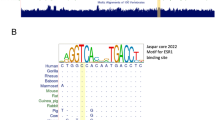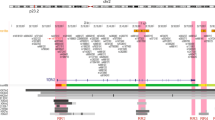Abstract
Involvement of the aryl hydrocarbon receptor (AHR) in carcinogenesis has been suggested in many studies. Upregulation of AHR has been reported in some cancer species, and an association between single-nucleotide polymorphisms (SNPs) of AHR and cancer risk or cancer development has also been reported. This evidence suggests the involvement of some specific SNPs in AHR transcriptional regulation in the process of carcinogenesis or cancer development, but there have been no studies to elucidate the mechanism involved. In this study, we identified the transcription factor Nuclear Factor 1-C (NF1C) as a candidate to regulate AHR transcription in a polymorphism-dependent manner. SNP rs10249788 was included in a consensus binding site for NF1C. Our results suggested that NF1C preferred the C allele to the T allele at rs10249788 for binding. Forced expression of NF1C suppressed the activity of the AHR promoter with C at rs10249788 stronger than that with T. Moreover, expression analysis of human uterine endometrial cancer (HEC) specimens showed greater upregulation of AHR and downregulation of NF1C than those of normal endometrium specimens. Sequence analysis showed HEC patients at advanced stages tended to possess T/T alleles more frequently than healthy women. We also demonstrated that NF1C suppressed proliferation, motility and invasion of HEC cells. This function was at least partially mediated by AHR. This study is the first to report that a polymorphism on the AHR regulatory region affected transcriptional regulation of the AHR gene in vitro. Because NF1C is a tumor suppressor, our new insights into AHR deregulation and its polymorphisms could reveal novel mechanisms of genetic susceptibility to cancer.
This is a preview of subscription content, access via your institution
Access options
Subscribe to this journal
Receive 50 print issues and online access
$259.00 per year
only $5.18 per issue
Buy this article
- Purchase on Springer Link
- Instant access to full article PDF
Prices may be subject to local taxes which are calculated during checkout







Similar content being viewed by others
References
Crews ST, Fan CM . Remembrance of things PAS: regulation of development by bHLH-PAS proteins. Curr Opin Genet Dev 1999; 9: 580–587.
Gu YZ, Hogenesch JB, Bradfield CA . The PAS superfamily: sensors of environmental and developmental signals. Annu Rev Pharmacol Toxicol 2000; 40: 519–561.
Marlowe JL, Puga A . Aryl hydrocarbon receptor, cell cycle regulation, toxicity, and tumorigenesis. J Cell Biochem 2005; 96: 1174–1184.
Opitz CA, Litzenburger UM, Sahm F, Ott M, Tritschler I, Trump S et al. An endogenous tumour-promoting ligand of the human aryl hydrocarbon receptor. Nature 2011; 478: 197–203.
Kiss EA, Vonarbourg C, Kopfmann S, Hobeika E, Finke D, Esser C et al. Natural aryl hydrocarbon receptor ligands control organogenesis of intestinal lymphoid follicles. Science 2011; 334: 1561–1565.
Li Y, Innocentin S, Withers DR, Roberts NA, Gallagher AR, Grigorieva EF et al. Exogenous stimuli maintain intraepithelial lymphocytes via aryl hydrocarbon receptor activation. Cell 2011; 147: 629–640.
Moennikes O, Loeppen S, Buchmann A, Andersson P, Ittrich C, Poellinger L et al. A constitutively active dioxin/aryl hydrocarbon receptor promotes hepatocarcinogenesis in mice. Cancer Res 2004; 64: 4707–4710.
Andersson P, McGuire J, Rubio C, Gradin K, Whitelaw ML, Pettersson S et al. A constitutively active dioxin/aryl hydrocarbon receptor induces stomach tumors. Proc Natl Acad Sci USA 2002; 99: 9990–9995.
Koliopanos A, Kleeff J, Xiao Y, Safe S, Zimmermann A, Buchler MW et al. Increased arylhydrocarbon receptor expression offers a potential therapeutic target for pancreatic cancer. Oncogene 2002; 21: 6059–6070.
Bradshaw TD, Trapani V, Vasselin DA, Westwell AD . The aryl hydrocarbon receptor in anticancer drug discovery: friend or foe? Curr Pharm Des 2002; 8: 2475–2490.
Lin P, Chang H, Tsai WT, Wu MH, Liao YS, Chen JT et al. Overexpression of aryl hydrocarbon receptor in human lung carcinomas. Toxicol Pathol 2003; 31: 22–30.
Schlezinger JJ, Liu D, Farago M, Seldin DC, Belguise K, Sonenshein GE et al. A role for the aryl hydrocarbon receptor in mammary gland tumorigenesis. Biol Chem 2006; 387: 1175–1187.
Anttila S, Tuominen P, Hirvonen A, Nurminen M, Karjalainen A, Hankinson O et al. CYP1A1 levels in lung tissue of tobacco smokers and polymorphisms of CYP1A1 and aromatic hydrocarbon receptor. Pharmacogenetics 2001; 11: 501–509.
Smart J, Daly AK . Variation in induced CYP1A1 levels: relationship to CYP1A1, Ah receptor and GSTM1 polymorphisms. Pharmacogenetics 2000; 10: 11–24.
Cauchi S, Stucker I, Solas C, Laurent-Puig P, Cenee S, Hemon D et al. Polymorphisms of human aryl hydrocarbon receptor (AhR) gene in a French population: relationship with CYP1A1 inducibility and lung cancer. Carcinogenesis 2001; 22: 1819–1824.
Wong JM, Okey AB, Harper PA . Human aryl hydrocarbon receptor polymorphisms that result in loss of CYP1A1 induction. Biochem Biophys Res Commun 2001; 288: 990–996.
Kim JH, Kim H, Lee KY, Kang JW, Lee KH, Park SY et al. Aryl hydrocarbon receptor gene polymorphisms affect lung cancer risk. Lung Cancer 2007; 56: 9–15.
Long JR, Egan KM, Dunning L, Shu XO, Cai Q, Cai H et al. Population-based case-control study of AhR (aryl hydrocarbon receptor) and CYP1A2 polymorphisms and breast cancer risk. Pharmacogenet Genomics 2006; 16: 237–243.
Nagata K, Guggenheimer RA, Hurwitz J . Adenovirus DNA replication in vitro: synthesis of full-length DNA with purified proteins. Proc Natl Acad Sci USA 1983; 80: 4266–4270.
Gronostajski RM . Roles of the NFI/CTF gene family in transcription and development. Gene 2000; 249: 31–45.
Nebl G, Mermod N, Cato AC . Post-transcriptional down-regulation of expression of transcription factor NF1 by Ha-ras oncogene. J Biol Chem 1994; 269: 7371–7378.
Yang BS, Gilbert JD, Freytag SO . Overexpression of Myc suppresses CCAAT transcription factor/nuclear factor 1-dependent promoters in vivo. Mol Cell Biol 1993; 13: 3093–3102.
Nilsson J, Helou K, Kovacs A, Bendahl PO, Bjursell G, Ferno M et al. Nuclear Janus-activated kinase 2/nuclear factor 1-C2 suppresses tumorigenesis and epithelial-to-mesenchymal transition by repressing Forkhead box F1. Cancer Res 2010; 70: 2020–2029.
Kukita Y, Miyatake K, Stokowski R, Hinds D, Higasa K, Wake N et al. Genome-wide definitive haplotypes determined using a collection of complete hydatidiform moles. Genome Res 2005; 15: 1511–1518.
Higasa K, Miyatake K, Kukita Y, Tahira T, Hayashi K . D-HaploDB: a database of definitive haplotypes determined by genotyping complete hydatidiform mole samples. Nucleic Acids Res 2007; 35: D685–D689.
Nagata K, Guggenheimer RA, Hurwitz J . Specific binding of a cellular DNA replication protein to the origin of replication of adenovirus DNA. Proc Natl Acad Sci USA 1983; 80: 6177–6181.
Hay RT . The origin of adenovirus DNA replication: minimal DNA sequence requirement in vivo. EMBO J 1985; 4: 421–426.
Johansson EM, Kannius-Janson M, Bjursell G, Nilsson J . The p53 tumor suppressor gene is regulated in vivo by nuclear factor 1-C2 in the mouse mammary gland during pregnancy. Oncogene 2003; 22: 6061–6070.
Kuchenhoff A, Seliger G, Klonisch T, Tscheudschilsuren G, Kaltwasser P, Seliger E et al. Arylhydrocarbon receptor expression in the human endometrium. Fertil Steril 1999; 71: 354–360.
Khorram O, Garthwaite M, Golos T . Uterine and ovarian aryl hydrocarbon receptor (AHR) and aryl hydrocarbon receptor nuclear translocator (ARNT) mRNA expression in benign and malignant gynaecological conditions. Mol Hum Reprod 2002; 8: 75–80.
Wormke M, Castro-Rivera E, Chen I, Safe S . Estrogen and aryl hydrocarbon receptor expression and crosstalk in human Ishikawa endometrial cancer cells. J Steroid Biochem Mol Biol 2000; 72: 197–207.
Kyo S, Nakamura M, Kiyono T, Maida Y, Kanaya T, Tanaka M et al. Successful immortalization of endometrial glandular cells with normal structural and functional characteristics. Am J Pathol 2003; 163: 2259–2269.
Belguise K, Guo S, Yang S, Rogers AE, Seldin DC, Sherr DH et al. Green tea polyphenols reverse cooperation between c-Rel and CK2 that induces the aryl hydrocarbon receptor, slug, and an invasive phenotype. Cancer Res 2007; 67: 11742–11750.
Ikuta T, Kawajiri K . Zinc finger transcription factor Slug is a novel target gene of aryl hydrocarbon receptor. Exp Cell Res 2006; 312: 3585–3594.
Eguchi H, Hayashi S, Watanabe J, Gotoh O, Kawajiri K . Molecular cloning of the human AH receptor gene promoter. Biochem Biophys Res Commun 1994; 203: 615–622.
Tang T, Lin X, Yang H, Zhou L, Wang Z, Shan G et al. Overexpression of antioxidant enzymes upregulates aryl hydrocarbon receptor expression via increased Sp1 DNA-binding activity. Free Radic Biol Med 2010; 49: 487–492.
Rafty LA, Santiago FS, Khachigian LM . NF1/X represses PDGF A-chain transcription by interacting with Sp1 and antagonizing Sp1 occupancy of the promoter. EMBO J 2002; 21: 334–343.
Ohtake F, Takeyama K, Matsumoto T, Kitagawa H, Yamamoto Y, Nohara K et al. Modulation of oestrogen receptor signalling by association with the activated dioxin receptor. Nature 2003; 423: 545–550.
Marconett CN, Sundar SN, Poindexter KM, Stueve TR, Bjeldanes LF, Firestone GL . Indole-3-carbinol triggers aryl hydrocarbon receptor-dependent estrogen receptor (ER)alpha protein degradation in breast cancer cells disrupting an ERalpha-GATA3 transcriptional cross-regulatory loop. Mol Biol Cell 2010; 21: 1166–1177.
Shehu A, Albarracin C, Devi YS, Luther K, Halperin J, Le J et al. The stimulation of HSD17B7 expression by estradiol provides a powerful feed-forward mechanism for estradiol biosynthesis in breast cancer cells. Mol Endocrinol 2011; 25: 754–766.
Abbott BD, Birnbaum LS, Perdew GH . Developmental expression of two members of a new class of transcription factors: I. Expression of aryl hydrocarbon receptor in the C57BL/6N mouse embryo. Dev Dyn 1995; 204: 133–143.
Chaudhry AZ, Lyons GE, Gronostajski RM . Expression patterns of the four nuclear factor I genes during mouse embryogenesis indicate a potential role in development. Dev Dyn 1997; 208: 313–325.
Kondo H, Qin M, Mizota A, Kondo M, Hayashi H, Hayashi K et al. A homozygosity-based search for mutations in patients with autosomal recessive retinitis pigmentosa, using microsatellite markers. Invest Ophthalmol Vis Sci 2004; 45: 4433–4439.
Livak KJ, Schmittgen TD . Analysis of relative gene expression data using real-time quantitative PCR and the 2(-Delta Delta C(T)) method. Methods 2001; 25: 402–408.
Rozen S, Skaletsky H . Primer3 on the WWW for general users and for biologist programmers. Methods Mol Biol 2000; 132: 365–386.
Asanoma K, Kubota K, Chakraborty D, Renaud SJ, Wake N, Fukushima K et al. SATB homeobox proteins regulate trophoblast stem cell renewal and differentiation. J Biol Chem 2012; 287: 2257–2268.
Ueoka Y, Kato K, Wake N . Hepatocyte growth factor modulates motility and invasiveness of ovarian carcinomas via ras mediated pathway. Mol Cell Endocrinol 2003; 202: 81–88.
Acknowledgements
We thank Dr Suminori Kono at the Division of Environmental and Social Medicine, Kyushu University for kindly providing us with DNA from blood samples. We appreciate the technical support from Kanako Okamoto, Dr Tomoko Yoneda and the Research Support Center, Graduate School of Medical Sciences, Kyushu University. We also thank Drs Kiyoko Kato and Kiyomi Tsukimori for their valuable discussions. This work was supported by a Grant-in-Aid (23249075, 23591596, 23791847 and 23592405) from the Ministry of Education, Culture, Sports, Science and Technology, Japan. This work was also partly supported by grants from The Ministry of Health, Labor and Welfare, and the Environment Technology Development Fund of the Ministry of the Environment, Japan.
Author information
Authors and Affiliations
Corresponding author
Ethics declarations
Competing interests
The authors declare no conflict of interest.
Additional information
Supplementary Information accompanies the paper on the Oncogene website
Rights and permissions
About this article
Cite this article
Li, D., Takao, T., Tsunematsu, R. et al. Inhibition of AHR transcription by NF1C is affected by a single-nucleotide polymorphism, and is involved in suppression of human uterine endometrial cancer. Oncogene 32, 4950–4959 (2013). https://doi.org/10.1038/onc.2012.509
Received:
Revised:
Accepted:
Published:
Issue Date:
DOI: https://doi.org/10.1038/onc.2012.509



